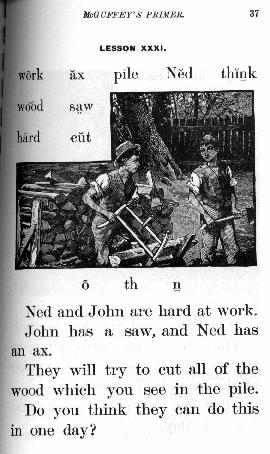McGuffey's Eclectic Primer

McGuffey, Wm. H. LL.D. McGuffey's Eclectic Primer. [Eclectic Educational Series]. NY: Van Nostrand Reinhold Company, Inc. 1909 Rev. Ed. p.27
By the 1880s, educators were concerned with emphasizing meaning from the beginning of the reading instruction. They were convinced that this could only occur through procedures that made use of sentential, or sentence-based, text in silent reading activities from the very first moment reading instruction was begun. As a result of their efforts, readers based on the Sentence and Story Method began to appear and by the early 1900s such readers dominated in American schools.
The crucial difference between Sentence and Story Method practices was in the initial presentation of the text. The Story Method approach required teacher to ‘tell’ the story -- reading the complete text aloud as it appeared in the reader. The children would then commit the story -- often a rhyme or fairy tale with repetitive refrains -- to memory, before being introduced to the printed text. In the Sentence Method the teacher prepared for the first reading of the story in piecemeal fashion, introducing through skillful questioning and the use of illustrations one sentence at a time. Each sentence was written on the black board or a prepared chart and was then read by the child so that, in a sense, the child was ‘discovering’ his way through the text. Story Method readers also used this approach, but only after the entire text had been read to the class and fully committed to memory. The memorization was often accompanied with dramatization and action response activities.
